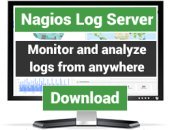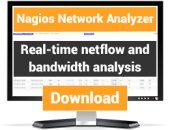Search Exchange
Search All Sites
Nagios Live Webinars
Let our experts show you how Nagios can help your organization.Login
Directory Tree
Nagios Twitter Hashtag Graphing
Current Version
1
Last Release Date
2016-11-04
Compatible With
- Nagios 3.x
- Nagios 4.x
- Nagios XI
Owner
Website
License
Other
Hits
5627
Files:
| File | Description |
|---|---|
| twitter_scripts.zip | twitter_scripts.zip |
Nagios Twitter Hashtag Graphing
(Twitter is a registered trademark of Twitter, Inc.)
============================
(c) 2016 Nagios Enterprises, Inc.
Bryan Heden - bheden@nagios.com
============================
- I've compiled the README into sections based on questions that you
may ask yourself after having downloaded this bundle of scripts
WHAT IS IT?
============================
- It's a Twitter tweet data aggregator/graphing utility
WHAT DOES IT DO?
============================
- One script creates a local database to store some information
- One script connects to Twitter's Streaming API with credentials you supply
and listens to incoming tweets based on search terms you define
- One script parses that tweet data and checks where it came from
- The last script is a Nagios plugin that converts all that data into
a beautiful graph
WHY WOULD YOU MAKE THAT?
============================
- We specifically wanted to correlate hashtag usage by US State during the
week directly before the 2016 Presidential Election
WHY DID YOU SHARE IT?
============================
- We thought maybe you'd like to do something cool like that, too
OK, OK - HOW DO I DO IT?
============================
*** NOTE: This isn't exactly easy, but trust me it is worth it :)
- You're gonna need a bit of software installed. If you're on CentOS, the following
lines should suffice:
yum install -y python-pip python-devel openssl-devel MySQL-python libffi-devel
pip install tweepy pyopenssl
*** NOTE: The previous lines were only tested on CentOS 6. Your mileage may vary
- You'll need somewhere to put the scripts. My suggestion is under /tmp/twitter
*** NOTE: The cron file is based on you using the /tmp/twitter location. If you decide on
somewhere else, make sure you update the cron file
- You need to set up the MySQL Database. Create your database
mysql < twitter.sql
- And then set up your credentials and make sure you update each of the scripts:
check_tweets.php
grab_tweets.php
streaming_twitter.py
- You'll need the Nagios plugin in your plugin directory. It is likely in /usr/local/nagios/libexec
cp check_tweets.php /usr/local/nagios/libexec
chown nagios:nagios /usr/local/nagios/libexec/check_tweets.php
chmod +x /usr/local/nagios/libexec/check_tweets.php
- You'll need a command definition in your Nagios configuration file:
define command {
command_name check_election_tweets
command_line $USER1$/check_tweets.php $ARG1$ $ARG2$ $ARG3$ $ARG4$ $ARG5$
}
- You need to get your Twitter API Credentials. That is a little out
of scope for this document, but going to
http://dev.twitter.com is a good start. You'll need an app, then go to the app
and select "keys and access tokens"
Once you have your access data, make sure to update the streaming_twitter.py file with your credentials
- You need to put the cron where it can be picked up.
cp cron /etc/cron.d/twitter.cron
- Now, you just need to create a Host and some Services so you can graph your data. That should look something like:
define service {
host_name Election Tweets
service_description Ohio Tweets
use generic-service
check_command check_election_tweets!-l "Hashtag1" -t "hashtag1"!-l "Hashtag Group1" -t "hashtag2,hashtag3"!-s oh -i 300!!!
initial_state o
max_check_attempts 5
check_interval 5
retry_interval 1
active_checks_enabled 1
check_period 24x7
notification_interval 60
first_notification_delay 0
notification_period 24x7
notifications_enabled 0
register 1
}
- That should do it!
- If you need help, you can reach out to me at bheden@nagios.com
(Twitter is a registered trademark of Twitter, Inc.)
============================
(c) 2016 Nagios Enterprises, Inc.
Bryan Heden - bheden@nagios.com
============================
- I've compiled the README into sections based on questions that you
may ask yourself after having downloaded this bundle of scripts
WHAT IS IT?
============================
- It's a Twitter tweet data aggregator/graphing utility
WHAT DOES IT DO?
============================
- One script creates a local database to store some information
- One script connects to Twitter's Streaming API with credentials you supply
and listens to incoming tweets based on search terms you define
- One script parses that tweet data and checks where it came from
- The last script is a Nagios plugin that converts all that data into
a beautiful graph
WHY WOULD YOU MAKE THAT?
============================
- We specifically wanted to correlate hashtag usage by US State during the
week directly before the 2016 Presidential Election
WHY DID YOU SHARE IT?
============================
- We thought maybe you'd like to do something cool like that, too
OK, OK - HOW DO I DO IT?
============================
*** NOTE: This isn't exactly easy, but trust me it is worth it :)
- You're gonna need a bit of software installed. If you're on CentOS, the following
lines should suffice:
yum install -y python-pip python-devel openssl-devel MySQL-python libffi-devel
pip install tweepy pyopenssl
*** NOTE: The previous lines were only tested on CentOS 6. Your mileage may vary
- You'll need somewhere to put the scripts. My suggestion is under /tmp/twitter
*** NOTE: The cron file is based on you using the /tmp/twitter location. If you decide on
somewhere else, make sure you update the cron file
- You need to set up the MySQL Database. Create your database
mysql < twitter.sql
- And then set up your credentials and make sure you update each of the scripts:
check_tweets.php
grab_tweets.php
streaming_twitter.py
- You'll need the Nagios plugin in your plugin directory. It is likely in /usr/local/nagios/libexec
cp check_tweets.php /usr/local/nagios/libexec
chown nagios:nagios /usr/local/nagios/libexec/check_tweets.php
chmod +x /usr/local/nagios/libexec/check_tweets.php
- You'll need a command definition in your Nagios configuration file:
define command {
command_name check_election_tweets
command_line $USER1$/check_tweets.php $ARG1$ $ARG2$ $ARG3$ $ARG4$ $ARG5$
}
- You need to get your Twitter API Credentials. That is a little out
of scope for this document, but going to
http://dev.twitter.com is a good start. You'll need an app, then go to the app
and select "keys and access tokens"
Once you have your access data, make sure to update the streaming_twitter.py file with your credentials
- You need to put the cron where it can be picked up.
cp cron /etc/cron.d/twitter.cron
- Now, you just need to create a Host and some Services so you can graph your data. That should look something like:
define service {
host_name Election Tweets
service_description Ohio Tweets
use generic-service
check_command check_election_tweets!-l "Hashtag1" -t "hashtag1"!-l "Hashtag Group1" -t "hashtag2,hashtag3"!-s oh -i 300!!!
initial_state o
max_check_attempts 5
check_interval 5
retry_interval 1
active_checks_enabled 1
check_period 24x7
notification_interval 60
first_notification_delay 0
notification_period 24x7
notifications_enabled 0
register 1
}
- That should do it!
- If you need help, you can reach out to me at bheden@nagios.com
Reviews (0)
Be the first to review this listing!


 New Listings
New Listings

